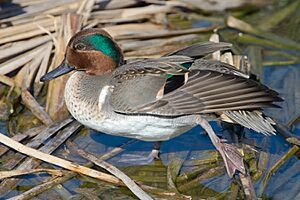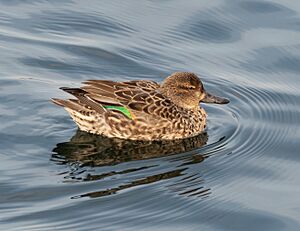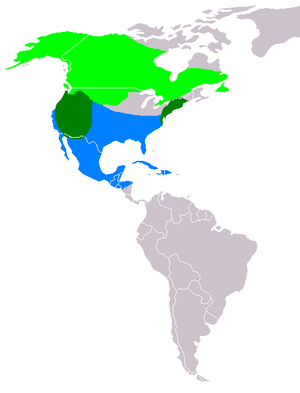Green-winged teal facts for kids
Quick facts for kids Green-winged teal |
|
|---|---|
 |
|
| Male | |
 |
|
| Female | |
| Conservation status | |
| Scientific classification | |
| Genus: |
Anas
|
| Species: |
carolinensis
|
 |
|
| Nesting range Year-round range Wintering range | |
| Synonyms | |
|
Anas crecca carolinensis |
|
The green-winged teal (scientific name: Anas carolinensis) is a small, common duck found across North America. It is also known as the American teal. These ducks breed in the northern parts of North America, but not on the Aleutian Islands.
For a while, scientists thought the green-winged teal was the same species as the Eurasian teal. However, most experts now agree they are different species. The scientific name Anas carolinensis comes from Latin. Anas means "duck," and carolinensis means "from Carolina."
This type of duck is called a dabbling duck. It means they feed by tipping their bodies forward in shallow water. Green-winged teals are also very migratory, flying far south for winter. When they are not breeding, they live in large groups. Their fast-flying flocks can look like wader birds.
Contents
About the Green-winged Teal
Naming and History
The green-winged teal was officially described in 1789 by a German scientist named Johann Friedrich Gmelin. He put it in the group of ducks called Anas. The name Anas carolinensis was given to it. This duck is a single species, meaning there are no different types (subspecies) recognized.
What They Look Like
The green-winged teal is the smallest dabbling duck in North America.
- Males: Breeding males have grey sides and back. Their rear end is yellow. They have a bright green patch on their wing, called a speculum, which is easy to see when they fly or rest. Their head is chestnut brown with a green patch around the eye. You can tell them apart from their European relatives by a white stripe on the side of their chest.
- Females: Females are light brown. Their feathers look a lot like a female mallard. You can tell them apart from most other ducks by their smaller size and the green speculum on their wing. It can be tricky to tell them apart from female common teals.
When males are not breeding, their feathers change. They look more like the females during this time.
Size and Weight
Green-winged teals are small ducks.
- Length: About 12 to 15 inches (31 to 39 cm) long.
- Weight: They weigh about 5 to 18 ounces (140 to 500 g).
- Wingspan: Their wings can spread about 20 to 23 inches (52 to 59 cm) wide.
Sounds They Make
These ducks can be quite noisy!
- Males: The male green-winged teal makes a clear whistling sound.
- Females: The female makes a soft quack sound.
Where They Live and What They Like
Distribution of Green-winged Teals
Green-winged teals breed from the Aleutian Islands in Alaska, across northern Canada, and south into parts of California, Nebraska, Kansas, Minnesota, Wisconsin, and the eastern Canadian provinces.
For winter, they fly south. They can be found from southern Alaska and British Columbia, east to New Brunswick, and south all the way to Central America. They also spend winters in Hawaii. Sometimes, they are even seen in northern South American countries like Venezuela and Colombia.
Their Favorite Habitats
These ducks love wetlands. You can find them in places like:
- Taiga bogs (swampy forests).
- Lakes, marshes, and shallow streams with lots of plants.
- Areas with tall grasses, bulrushes, cattails, and pondweeds.
They prefer shallow water and smaller ponds, especially during the breeding season. You might see them resting on mudbanks, tree stumps, or even perching on low branches of dead trees.
Winter Migration
In the northern United States, green-winged teals start flying to their winter homes from early September to mid-December. In central areas, they arrive in September and stay until December. In their southernmost wintering spots, they arrive in late September, but most show up in late November.
Life Cycle and Behavior
Breeding and Nests
Green-winged teals are some of the first birds to return to their nesting areas in spring, as soon as the snow melts. They start leaving their winter homes in February and continue through April.
They are ready to have babies after their first winter.
- Nests: They build their nests on dry ground, usually hidden under thick grass, weeds, or bushes. The nests are often close to water, but not in areas without trees or bushes.
- Eggs: A female can lay between 5 and 16 eggs.
- Incubation: The eggs hatch after about 21 to 23 days.
- Ducklings: The young ducklings can fly (fledge) about 34 to 35 days after hatching. This is one of the fastest growth rates for any duck!
After the female starts sitting on the eggs, the males leave. They gather in safe water areas to molt (change their feathers). Females molt their feathers on the breeding grounds.
What They Eat
Green-winged teals often look for food on mud flats. If there are no mud flats, they will feed in shallow marshes or flooded farm fields.
They mostly eat plants:
- Seeds: They like small seeds from plants like nutgrasses, millets, and sedges. They also eat corn, wheat, barley, and buttonbush seeds. In marshes, they eat seeds from bulrushes, pondweeds, and spikerushes.
- Plant Parts: They also eat leaves and stems of plants like muskgrass, pondweeds, and duckweeds.
Sometimes, they will also eat insects, snails, and small crustaceans. In spring, they might even eat maggots found around ponds.
Predators
Many animals hunt green-winged teals. Some common predators include:


